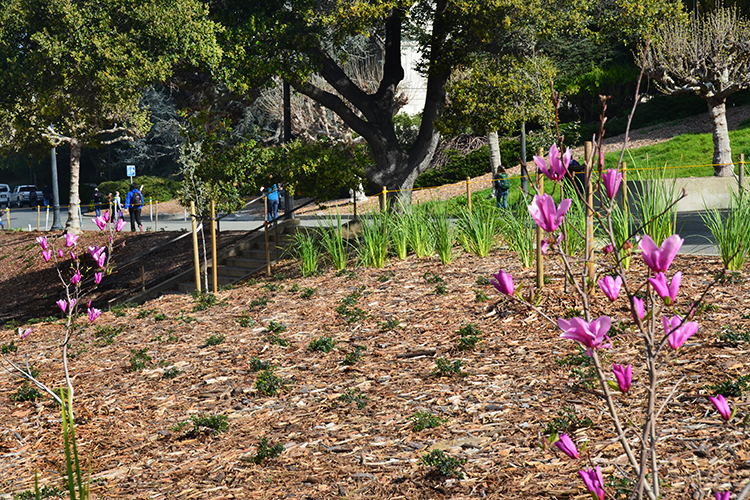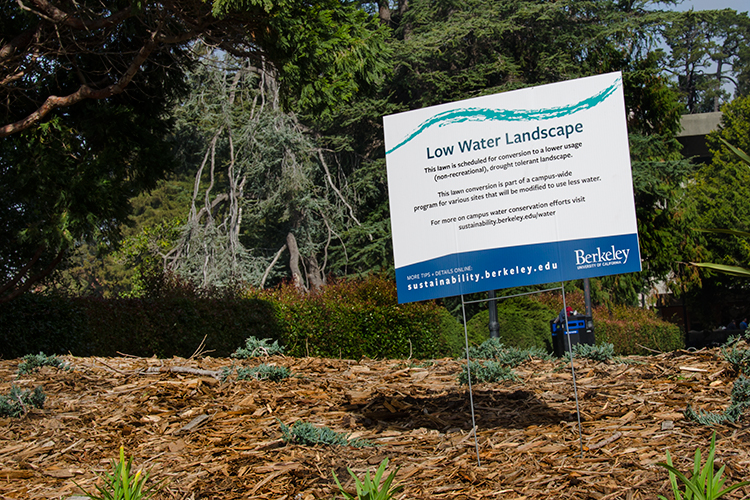Converting lawns to low-water beds, as drought persists
Four years into a record-breaking drought, the campus has been replacing selected campus lawns with beds of regionally appropriate, drought-tolerant plantings.

April 4, 2016
Four years into a record-breaking drought, work crews have spent the past months replacing selected grass lawns on the UC Berkeley campus with mulched beds and regionally appropriate, drought-tolerant plantings. (Text continues below slideshow.)
On the south side of Durant Hall, three thick-barked cork oaks are currently setting down roots in what used to be a small island of grass surrounded by paved walkways that made it an uninviting spot to lounge. In February, landscaping crews also planted manzanitas, magnolias and fortnight lilies, the latter of which will produce a mass bloom of white flowers six months of the year, starting in spring.
Workers also installed state-of-the-art water-efficient irrigation heads and a border of straw wattles, designed to prevent silt and recycled wood mulch from getting into Strawberry Creek.
According to campus landscape architect David Johnson, the drought-tolerant landscaping is part of a master plan created by his predecessor, Jim Horner. Campus-renewal funds, as well as students’ The Green Initiative Fund (TGIF), have paid for water-wise landscape upgrades.
A “fairly dramatic” amount of lawn (about 3.5 acres) has so far been converted, Johnson says — some to planted beds, some to mulch alone until future funding is secured.

Work crews are installing straw wattles to prevent mulch from escaping from this bed.
Cannalilies and dwarf olives now flank the flagpole west of California Hall, where the annual campus memorial is held. On the west side of University House, a large grass lawn has been replaced with an olive grove dotted with cork oaks, Italian cypress and Grecian laurels. At the West Crescent, sedges, native strawberries, bear’s breech, coffeeberry, dogwoods, buckeye and magnolias border the creek.
Earlier, Grounds Operations sponsored work just south of Birge Hall, with local volunteers helping to replace turf with ground covers and perennials.
The drought has taken a toll on campus flora, Johnson says. Last year several redwoods perished for lack of water. And a number of lawns and established trees became stressed, he notes, as UC Berkeley complied with water-use restrictions mandated by EBMUD, the local water utility.
Irrigating a lawn two or three times per week from May to November requires three to four feet of H20, according to Johnson. In contrast, “once established in a year or two, the new drought-tolerant plantings will only need a foot of water to survive the summer.”
Rainfall this past winter has returned to normal levels and greened up campus lawns, but climatologists say the drought isn’t over, cautions Lisa McNeilly, director of sustainability and energy. “Just as the campus is still working to conserve water, we hope that our community does the same.”
Campus water consumption is down 9.2 percent since January 2013, when the drought was officially declared, according to recent data. Grounds account for 8 percent of the total, says Johnson. “But we want to get it lower.”
Related information:
- Every drop counts: Taking steps to conserve water (Berkeley News article, 2014)
- Real Estate division’s “Drought Response” page










